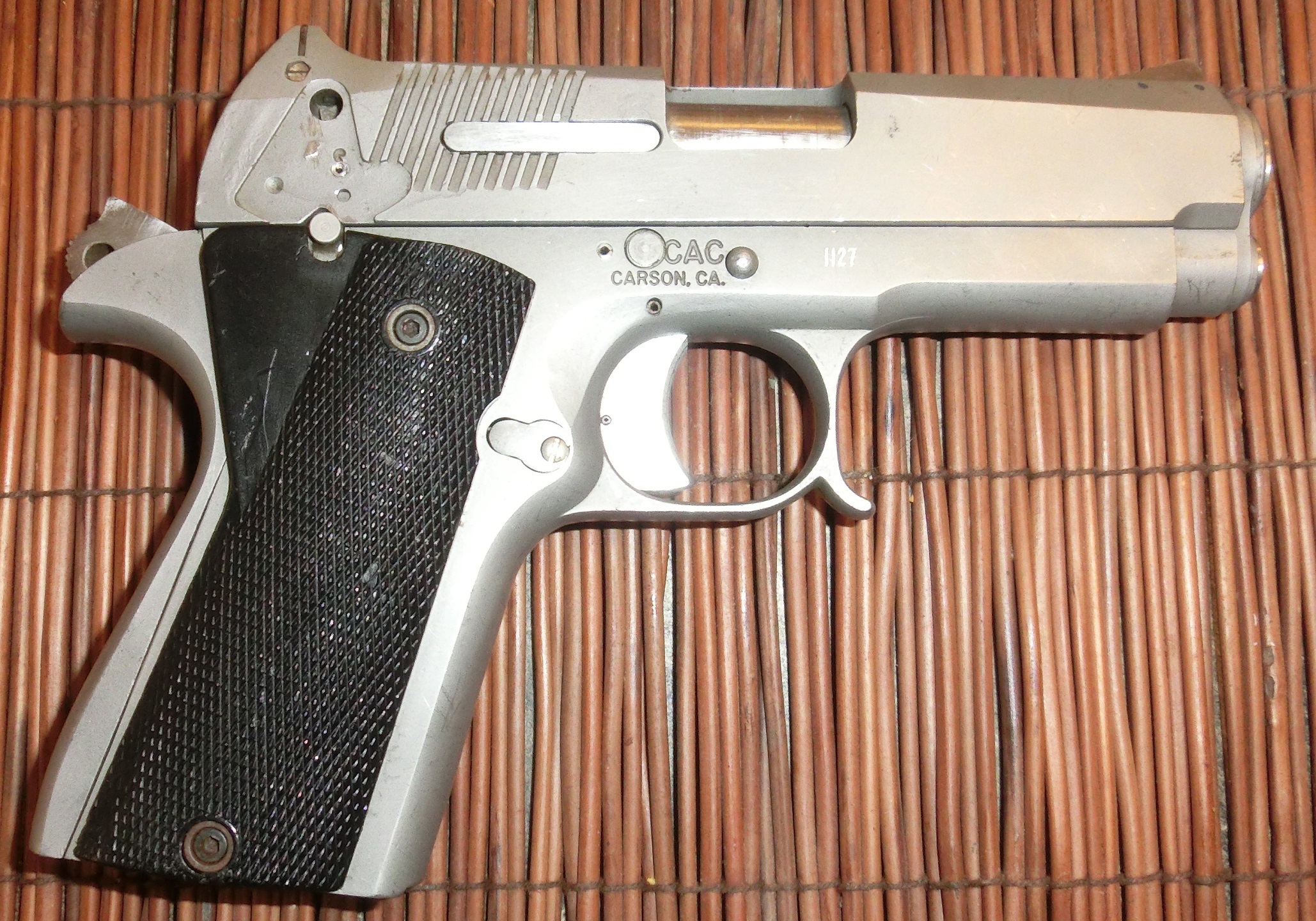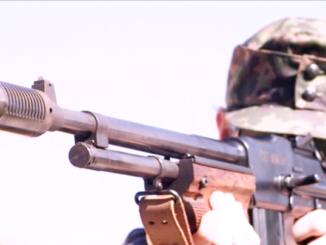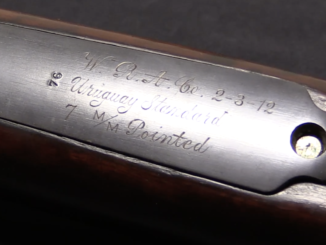Given the status of the AR15 as the preeminent military rifle still today, it comes as a surprise to many people to learn just how old the gun really is. Civilian production of the SP-1 model by Colt actually began in 1964, which means that early SP-1 rifles started becoming Curio & Relic qualified back in 2014. Right now in 2017, more than 10,000 C&R AR15s exist – and this is one of them.
Related Articles

Semiauto pistol
Mossberg’s Combat .45
Think about the really stereotypical service pistol for the 21st century (so far) – it would be something with a polymer frame, large magazine capacity, minimum of manual controls, and a striker with a safety […]

Select-fire Rifles
Colt Monitor: The First Official FBI Fighting Rifle
The Colt Monitor was Colt’s improved version os the Browning Automatic Rifle intended for the law enforcement market. Colt had the sales rights to the BAR in North and South American (as well as a […]

Bolt Action Rifles
Winchester Reference Collection: Uruguayan M1908 Short Rifle
Uruguay first adopted a Mauser rifle in the 1880s, with the single-shot Mauser model 1871. After an abortive attempt to update those rifles to a small bore smokeless powder cartridge (the Dovitiis conversion), they opted […]

Doesn’t C&R status only apply if the rifle is in its original configuration?
No, it doesn’t work with full automatic weapons
True, but the Colt SP-1 was a semi-automatic only civilian version of the Armalite. As such, it falls under the C&R category once it passes 50 years of age.
The Armalite AR-180s will begin to reach that status this year, as the first production run was in late 1967. The Ruger Mini-14 early models will qualify in 2023.
Most of the Universal, Plainfield, and Iver Johnson M-1 Carbine clones will be C&R eligible within the next five years as production of them ran from the early 1960s to the mid-1970s for the most part.
I believe the commercial semi-auto only Beretta BM-59 series already qualifies, as production of those lasted only from 1961 to 1965. Early civilian CETME rifles (Spanish version of the H&K 91 series) also should already qualify, as they were produced from late 1959 to mid-1967.
cheers
eon
Sadly for us intellectuals who happen to have interests in the firearms of half a century past, naïve gun-control advocates seem to believe that just having any gun will allow a person to turn into some super crazy serial killer who will litter the floor with bloodied police badges and severed heads. And thus, those idiots will think that EVERY member of the AR family was likely made “EXTREMELY RECENTLY” if only because the stock is plastic and refuse to believe that any AR-15 (no matter how old) could possibly qualify as a curio/relic piece.
Did I mess up?
“stock is plastic”
Which, BTW, was introduced first in sporting fire-arms, namely Tenite http://extranosalley.com/tenite-gun-stocks/ was used in 1940s, for example in Stevens 22-410, it was non-automatic non-magazine fire-arm featuring two barrels (one for .22 rim-fire other for .410 shot-shell as name implies) and later used in Remington Nylon 66 – .22 rim-fire self-loading rifle.
is: “(…)later used(…)”
should be: “(…)later Zytel-101 was used(…)”
Actually, C&R status applies to NFA weapons (including machineguns).
Of course, all that means is that you can buy one across state lines and only pay one registratuion tax (and wait period), because you don’t have to filter the sale through an NFA dealer in your home state. When transferring a non-C&R NFA “firearm” across state lines,the seller has to transfer the gun to an NFA dealer in the buyer’s state, including the registration tax (unless the seller is also an NFA dealer – dealer to dealer transfers are tax exempt) and waiting for the transfer TO the receiving dealer to be approved, and ONLY THEN does the actual buyer apply to have the gun transferred from the dealer to himself.
You still have to go through the same NFA registration process when it is a C&R eligible gun — only you can skip the transfer dealer (and thus the time and tax are halved – only one transfer approval wait and one $200 tax, instead of two each.)
Well, becoming eligible and treated as eligible are two different things. I just bought a 93 Mauser made in 1896 (clearly marked on the receiver) that a seller would only send to an FFL and the dealer made me fill out a 4473. “Oh look a squirrel”…what I write now when I get off subject on a thread. I want to restore a Spanish Crest onto this 93 as I am “restoring it” to Spanish American War configuration so it will inspire me to kick a friends butt who has piece of crap Krag in our own Ian inspired little Spanish American War challenge (not going to film it, don’t have the talent or equipment for that). Know anyone who does this sort of work, maybe with etching (if I can’t find anyone I will do the etching myself methinks-can’t hurt it). I need a rubbing of the crest though to get the detail and the scale correct (Can anyone help me out on that?). Photos so far are not sufficiently detailed. I am not trying to make a perfect crest but something I won’t be embarrassed about either.
If I recall correctly the screw front pin is two-fold. First it makes it (a little) harder to put an M16 upper on an SP1 lower; second the no-fence lower’s pin was non-captive and needs an counterbore operation on the front lug.
The rifle shown is such a mix-master!
This gun was and still is very advanced for its age; given particular design intent (such as small bore-high velocity projectile introduction). It was not particularly light when compared with other rifles, but it was lighter than previous model in service and that was selling point. Its conception was setup with preference of use of forgings (which made it labour intensive) but hey, this was America.
I admit that I was, technically speaking, very excited when I first read about this rifle while still over in Europe and even continued to praise it while in military service. Later I realized how potentially dangerous it was – praising enemy’s weapon. Ironically, bit later on I had the chance to actually work with it. One’s future is unpredictable…. isn’t it.
How original must a firearms be for C&R status? What degree of originality is required? BATFE’s FAQ’s on the subject suggests that the firearm needs to be in original condition. Does the date the receiver left the factory determine that a firearms is a C&R? For example, I do not believe the rifle shown in the video is in original condition. This would be less of an issue let’s say with a restored older firearm than one made of interchangeable parts like the AR15.
The gun in the video appears to me to consist of an upper receiver assembly from a gun made in the late 1980’s and a lower made from mixed parts. The upper receiver has a transitional tear drop forward assist that did not appear in production until the mid to late 1980’s. The chromed bolt carrier is also wrong. Colt produced no chromed bolt carriers (with the exception of a run of 1,000 Colt Guard finished guns in the 203,xxx s/n range years later). A correct 1967 SP1 would have a slick side parkerized bolt carrier and a parkerized bolt (the chromed bolt was phased out in the preceeding year.) A correct 1967 SP1 should have a pronged flash hider secured with the unique textured crush washer with a diagonal cut. The A1 birdcage was not phased into Colt’s civilian AR15 production until at least two if not three years later. Then the dust cover has the large square pad that was phased out early on in 1966. The lower receiver is also questionable as a C&R. The butt stock is incorrect appearing to be an A2 butt stock in the modern configuration with trap door, fixed swivel and 13.5″. The correct butt stock has a rounded butt with no storage compartment, hinged swivels and a 13″ LOP. Interestingly, the trigger and hammer pins appear to pre-date 1967 and have the dimpled manufacturing artifact associated with the earliest SP1’s of 1964-1965 serial ranges.
So this video is an interesting illustration of the potential dangers of collecting curios and relics in more modern firearms. “ATF has recognized only complete, assembled firearms as curios or relics. ATF’s classification of surplus military firearms as curios or relics has extended only to those firearms in their original military configuration. Frames or receivers of curios or relics are not generally recognized as curios or relics.” https://www.atf.gov/firearms/qa/what-firearms-are-considered-be-curio-and-relic-firearms
Manufacture date of 50 years ago or more is the critical date. And the *receiver* is the magic part, because “the receiver is the firearm”. That does not mean you can take a C&R receiver and do whatever you want with it… although you *can* restore a stripped receiver. (And, IIRC, a stripped receiver by itself is not considered C&R eligible, because it wasn’t sold that way 50 years ago.)
Post-manufacture parts do *not* alter that date, *unless* they change the gun to a configuration that doesn’t correspond with that date. This allows you to “restore” a gun that has been “Bubba’d” into a non-C&R eligble configuration, using later parts that match the C&R configuration.
You *might* be able to build a faux-carbine/aircrew survival rifle (which they had 50 years ago) off a C&R AR15 receiver, but you couldn’t, for instance, drop a flat top upper and a six position carbine buffer on it and maintain it as a C&R gun.
I purchased my A-1 in the 1970’s and she is 100% correct. date of man. 1970 and has never been altered. she sports a storage compartment in the butt stock, which is shorter than my A-2.She carries the A-1 birdcage, and is slick sided, the pistol grip is bakelite material with no finger groove. she has a 1-12 twist chrome lined pencil barrel with the triangle widow maker fore grips She came with 2 colt steel 20 rnd. mags. I had not considered that she was C&R Eligible.. that’s cool to know… Cool.
I became C & R eligible in 2007, but Robin might say that I’m too worn out to be considered.